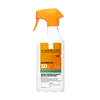What's inside
What's inside
 Key Ingredients
Key Ingredients

 Benefits
Benefits

 Concerns
Concerns

 Ingredients Side-by-side
Ingredients Side-by-side

Water
Skin ConditioningDicaprylyl Carbonate
EmollientMethylene Bis-Benzotriazolyl Tetramethylbutylphenol
UV FilterDiisopropyl Sebacate
EmollientButyl Methoxydibenzoylmethane
UV AbsorberEthylhexyl Triazone
UV AbsorberGlycerin
HumectantDecyl Glucoside
CleansingMethylpropanediol
SolventC20-22 Alkyl Phosphate
EmulsifyingEthylhexyl Methoxycrylene
Skin ConditioningC20-22 Alcohols
Emulsion StabilisingPentylene Glycol
Skin ConditioningMicrocrystalline Cellulose
AbsorbentDisodium EDTA
1,2-Hexanediol
Skin ConditioningCaprylyl Glycol
EmollientMannitol
HumectantXylitol
HumectantPropylene Glycol
HumectantCellulose Gum
Emulsion StabilisingCitric Acid
BufferingSodium Hydroxide
BufferingRhamnose
HumectantXanthan Gum
EmulsifyingEctoin
Skin ConditioningTocopherol
AntioxidantFructooligosaccharides
HumectantCaprylic/Capric Triglyceride
MaskingLaminaria Ochroleuca Extract
Skin ConditioningWater, Dicaprylyl Carbonate, Methylene Bis-Benzotriazolyl Tetramethylbutylphenol, Diisopropyl Sebacate, Butyl Methoxydibenzoylmethane, Ethylhexyl Triazone, Glycerin, Decyl Glucoside, Methylpropanediol, C20-22 Alkyl Phosphate, Ethylhexyl Methoxycrylene, C20-22 Alcohols, Pentylene Glycol, Microcrystalline Cellulose, Disodium EDTA, 1,2-Hexanediol, Caprylyl Glycol, Mannitol, Xylitol, Propylene Glycol, Cellulose Gum, Citric Acid, Sodium Hydroxide, Rhamnose, Xanthan Gum, Ectoin, Tocopherol, Fructooligosaccharides, Caprylic/Capric Triglyceride, Laminaria Ochroleuca Extract
Water
Skin ConditioningAlcohol Denat.
AntimicrobialHomosalate
Skin ConditioningEthylhexyl Salicylate
UV AbsorberButyl Methoxydibenzoylmethane
UV AbsorberEthylhexyl Triazone
UV AbsorberOctocrylene
UV AbsorberGlycerin
HumectantPropanediol
SolventBis-Ethylhexyloxyphenol Methoxyphenyl Triazine
Skin ConditioningC12-22 Alkyl Acrylate/Hydroxyethylacrylate Copolymer
StabilisingDiisopropyl Adipate
EmollientDiisopropyl Sebacate
EmollientDicaprylyl Ether
EmollientTriethanolamine
BufferingTocopherol
AntioxidantPhenylbenzimidazole Sulfonic Acid
UV AbsorberAcrylates/C10-30 Alkyl Acrylate Crosspolymer
Emulsion StabilisingCaprylyl Glycol
EmollientDrometrizole Trisiloxane
UV AbsorberSodium Polyacrylate
AbsorbentTrisodium Ethylenediamine Disuccinate
Parfum
MaskingWater, Alcohol Denat., Homosalate, Ethylhexyl Salicylate, Butyl Methoxydibenzoylmethane, Ethylhexyl Triazone, Octocrylene, Glycerin, Propanediol, Bis-Ethylhexyloxyphenol Methoxyphenyl Triazine, C12-22 Alkyl Acrylate/Hydroxyethylacrylate Copolymer, Diisopropyl Adipate, Diisopropyl Sebacate, Dicaprylyl Ether, Triethanolamine, Tocopherol, Phenylbenzimidazole Sulfonic Acid, Acrylates/C10-30 Alkyl Acrylate Crosspolymer, Caprylyl Glycol, Drometrizole Trisiloxane, Sodium Polyacrylate, Trisodium Ethylenediamine Disuccinate, Parfum
 Reviews
Reviews

Ingredients Explained
These ingredients are found in both products.
Ingredients higher up in an ingredient list are typically present in a larger amount.
Also known as Avobenzone, this ingredient is a chemical sunscreen filter that provides protection in the UV-A range.
Avobenzone is globally approved and is the most commonly used UV-A filter in the world.
Studies have found that avobenzone becomes ineffective when exposed to UV light (it is not photostable; meaning that it breaks down in sunlight). Because of this, formulations that include avobenzone will usually contain stabilizers such as octocrylene.
However, some modern formulations (looking at you, EU!) are able to stabilize avobenzone by coating the molecules.
Avobenzone does not protect against the UV-B range, so it's important to check that the sunscreen you're using contains other UV filters that do!
The highest concentration of avobenzone permitted is 3% in the US, and 5% in the EU.
Learn more about Butyl MethoxydibenzoylmethaneCaprylyl Glycol is a humectant and emollient, meaning it attracts and preserves moisture.
It is a common ingredient in many products, especially those designed to hydrate skin. The primary benefits are retaining moisture, skin softening, and promoting a healthy skin barrier.
Though Caprylyl Glycol is an alcohol derived from fatty acids, it is not the kind that can dry out skin.
This ingredient is also used as a preservative to extend the life of products. It has slight antimicrobial properties.
Learn more about Caprylyl GlycolWe don't have a description for Diisopropyl Sebacate yet.
Ethylhexyl Triazone is a modern chemical sunscreen that protects from UV-B radiation.
It is the most effective of existing UV-B filters, as it provides the highest level of photo-stable absorption. It protects from the entire UV-B range (280 to 320nm), with it's highest level of protection at 314nm.
Ethylhexyl Triazone is oil soluble, oderless and colorless, which mean it is able to be incorporated into a variety of different formulations.
It is not currently available within the United States due to slow changing FDA regulations. Outside of the US, it is used in formulations at concentrations up to 5%.
Learn more about Ethylhexyl TriazoneGlycerin is already naturally found in your skin. It helps moisturize and protect your skin.
A study from 2016 found glycerin to be more effective as a humectant than AHAs and hyaluronic acid.
As a humectant, it helps the skin stay hydrated by pulling moisture to your skin. The low molecular weight of glycerin allows it to pull moisture into the deeper layers of your skin.
Hydrated skin improves your skin barrier; Your skin barrier helps protect against irritants and bacteria.
Glycerin has also been found to have antimicrobial and antiviral properties. Due to these properties, glycerin is often used in wound and burn treatments.
In cosmetics, glycerin is usually derived from plants such as soybean or palm. However, it can also be sourced from animals, such as tallow or animal fat.
This ingredient is organic, colorless, odorless, and non-toxic.
Glycerin is the name for this ingredient in American English. British English uses Glycerol/Glycerine.
Learn more about GlycerinTocopherol (also known as Vitamin E) is a common antioxidant used to help protect the skin from free-radicals and strengthen the skin barrier. It's also fat soluble - this means our skin is great at absorbing it.
Vitamin E also helps keep your natural skin lipids healthy. Your lipid skin barrier naturally consists of lipids, ceramides, and fatty acids. Vitamin E offers extra protection for your skin’s lipid barrier, keeping your skin healthy and nourished.
Another benefit is a bit of UV protection. Vitamin E helps reduce the damage caused by UVB rays. (It should not replace your sunscreen). Combining it with Vitamin C can decrease sunburned cells and hyperpigmentation after UV exposure.
You might have noticed Vitamin E + C often paired together. This is because it is great at stabilizing Vitamin C. Using the two together helps increase the effectiveness of both ingredients.
There are often claims that Vitamin E can reduce/prevent scarring, but these claims haven't been confirmed by scientific research.
Learn more about TocopherolWater. It's the most common cosmetic ingredient of all. You'll usually see it at the top of ingredient lists, meaning that it makes up the largest part of the product.
So why is it so popular? Water most often acts as a solvent - this means that it helps dissolve other ingredients into the formulation.
You'll also recognize water as that liquid we all need to stay alive. If you see this, drink a glass of water. Stay hydrated!
Learn more about Water